President Donald Trump signed a memorandum on Thursday instructing his administration to pursue reciprocal tariffs against nations that put fees on U.S. exports, escalating a trade war that could lead to higher costs for Americans, reports USA Today.
Tailored Counter Measures
The tariffs are expected to be equivalent to the fees that individual countries put on products that are imported from the U.S., including tariffs and taxes, and take into account regulatory requirements and subsidies affecting U.S. businesses and consumers.
“Whatever they charge us, we’re charging them,” Trump said. “It’s a beautiful simple system.” The new approach reflects concern in the administration over fees that are typically passed on to consumers such as the value-added tax (VAT), which other nations use in place of a sales tax…”
The process will be led by the Secretary of Commerce and U.S. Trade Representative in consultation with the Treasury secretary, Homeland Security secretary, and Trump’s economic team at the White House.
Tariff Conundrum
The tariffs have hit competitors and allies, riling Democratic lawmakers, who say the measures are counterproductive to Trump’s goals of helping American workers, and U.S. partners, who are now threatening sharp increases of their own.
The White House said it was putting Office of Management and Budget Director Russell Vought in charge of writing and submitting a report within 180 days assessing the fiscal impacts. But the move was designed to fulfill a requirement in the law, rather than to prompt a review and potential reversal in the administration’s actions.
European VAT
Trump has singled out the European Union, which had a trade deficit of $235.6 billion in 2024, according to the U.S. Census Bureau, and its value-added tax as a deterrent to the purchase of exports from the United States, specifically cars. A value-added tax, or VAT, is a nationwide consumption tax that’s levied on every stage of production and distribution of goods and services but ultimately paid by consumers. VAT can also be levied on imports when they enter a country.
It’s usually a percentage slapped on the price of a good or service. For example, if a product costs $100 and there is a 15% VAT, the consumer pays $115 to the merchant. The merchant keeps $100 and $15, or the amount of the tax goes to the government.
More than 170 countries around the world use VAT to generate revenue, according to the Organization for Economic Cooperation and Development. The worldwide average VAT rate is around 15%, with regional averages ranging from 12% in Asia to 20% in Europe, the Tax Foundation said.
Did you subscribe to our daily Newsletter?
It’s Free Click here to Subscribe!
Source: USA Today
















